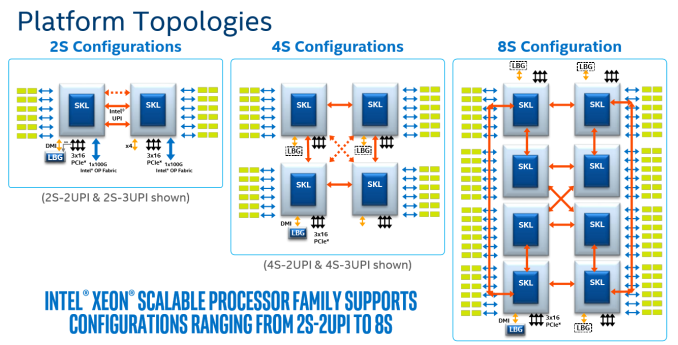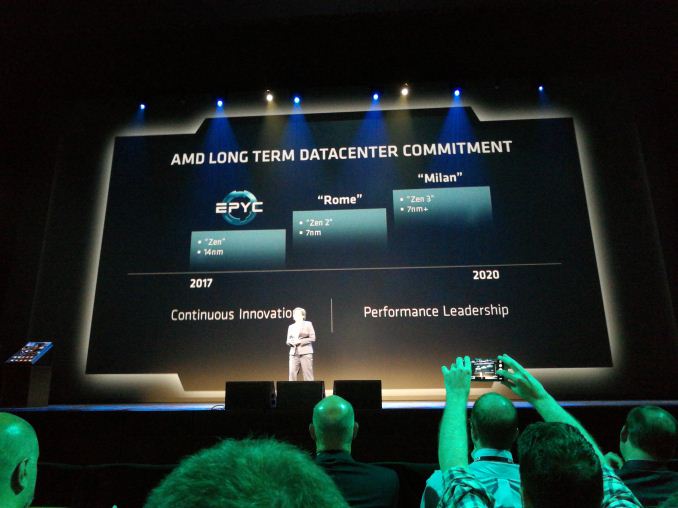Sizing Up Servers: Intel's Skylake-SP Xeon versus AMD's EPYC 7000 - The Server CPU Battle of the Decade?
by Johan De Gelas & Ian Cutress on July 11, 2017 12:15 PM EST- Posted in
- CPUs
- AMD
- Intel
- Xeon
- Enterprise
- Skylake
- Zen
- Naples
- Skylake-SP
- EPYC
Closing Thoughts
First of all, we have to emphasize that we were only able to spend about a week on the AMD server, and about two weeks on the Intel system. With the complexity of both server hardware and especially server software, that is very little time. There is still a lot to test and tune, but the general picture is clear.
We can continue to talk about Intel's excellent mesh topology and AMD strong new Zen architecture, but at the end of the day, the "how" will not matter to infrastructure professionals. Depending on your situation, performance, performance-per-watt, and/or performance-per-dollar are what matters.
The current Intel pricing draws the first line. If performance-per-dollar matters to you, AMD's EPYC pricing is very competitive for a wide range of software applications. With the exception of database software and vectorizable HPC code, AMD's EPYC 7601 ($4200) offers slightly less or slightly better performance than Intel's Xeon 8176 ($8000+). However the real competitor is probably the Xeon 8160, which has 4 (-14%) fewer cores and slightly lower turbo clocks (-100 or -200 MHz). We expect that this CPU will likely offer 15% lower performance, and yet it still costs about $500 more ($4700) than the best EPYC. Of course, everything will depend on the final server system price, but it looks like AMD's new EPYC will put some serious performance-per-dollar pressure on the Intel line.
The Intel chip is indeed able to scale up in 8 sockets systems, but frankly that market is shrinking fast, and dual socket buyers could not care less.
Meanwhile, although we have yet to test it, AMD's single socket offering looks even more attractive. We estimate that a single EPYC 7551P would indeed outperform many of the dual Silver Xeon solutions. Overall the single-socket EPYC gives you about 8 cores more at similar clockspeeds than the 2P Intel, and AMD doesn't require explicit cross socket communication - the server board gets simpler and thus cheaper. For price conscious server buyers, this is an excellent option.
However, if your software is expensive, everything changes. In that case, you care less about the heavy price tags of the Platinum Xeons. For those scenarios, Intel's Skylake-EP Xeons deliver the highest single threaded performance (courtesy of the 3.8 GHz turbo clock), high throughput without much (hardware) tuning, and server managers get the reassurance of Intel's reliable track record. And if you use expensive HPC software, you will probably get the benefits of Intel's beefy AVX 2.0 and/or AVX-512 implementations.
The second consideration is the type of buyer. It is clear that you have to tune more and work harder to get the best performance out of AMD EPYC CPUs. In many ways it is basically a "virtual octal socket" solution. For enterprises with a small infrastructure crew and server hardware on premise, spending time on hardware tuning is not an option most of the time. For the cloud vendors, the knowledge will be available and tuning for EPYC will be a one-time investment. Microsoft is already deploying AMD's EPYC in their Azure Cloud Datacenters.
Looking Towards the Future
Looking towards the future, Intel has the better topology to add more cores in future CPU generations. However AMD's newest core is a formidable opponent. Scalar floating point operations are clearly faster on the AMD core, and integer performance is – at the same clock – on par with Intel's best. The dual CCX layout and quad die setup leave quite a bit of performance on the table, so it will be interesting how much AMD has learned from this when they launch the 7 nm "Rome" successor. Their SKU line-up is still very limited.
All in all, it must be said that AMD executed very well and delivered a new server CPU that can offer competitive performance for a lower price point in some key markets. Server customers with non-scalar sparse matrix HPC and Big Data applications should especially take notice.
As for Intel, the company has delivered a very attractive and well scaling product. But some of the technological advances in Skylake-SP are overshadowed by the heavy price tags and somewhat "over the top" market segmentation.












219 Comments
View All Comments
msroadkill612 - Wednesday, July 12, 2017 - link
It looks interesting. Do u have a point?Are you saying they have a place in this epyc debate? using cheaper ddr3 ram on epyc?
yuhong - Friday, July 14, 2017 - link
"We were told from Intel that ‘only 0.5% of the market actually uses those quad ranked and LR DRAMs’, "intelemployee2012 - Wednesday, July 12, 2017 - link
what kind of a forum and website is this? we can't delete the account, cannot edit a comment for fixing typos, cannot edit username, cannot contact an admin if we need to report something. Will never use these websites from now on.Ryan Smith - Wednesday, July 12, 2017 - link
"what kind of a forum and website is this?"The basic kind. It's not meant to be a replacement for forums, but rather a way to comment on the article. Deleting/editing comments is specifically not supported to prevent people from pulling Reddit-style shenanigans. The idea is that you post once, and you post something meaningful.
As for any other issues you may have, you are welcome to contact me directly.
Ranger1065 - Thursday, July 13, 2017 - link
That's a relief :)iwod - Wednesday, July 12, 2017 - link
I cant believe what i just read. While I knew Zen was good for Desktop, i expected the battle to be in Intel's flavour on the Server since Intel has years to tune and work on those workload. But instead, we have a much CHEAPER AMD CPU that perform Better / Same or Slightly worst in several cases, using much LOWER Energy during workload, while using a not as advance 14nm node compared to Intel!And NO words on stability problems from running these test on AMD. This is like Athlon 64 all over again!
pSupaNova - Wednesday, July 12, 2017 - link
Yes it is.But this time much worse for Intel with their manufacturing lead shrinking along with their workforce.
Shankar1962 - Wednesday, July 12, 2017 - link
Competition has spoiled the naming convention Intels 14 === competetions 7 or 10Intel publicly challenged everyone to revisit the metrics and no one responded
Can we discuss the yield density and scaling metrics? Intel used to maintain 2year lead now grew that to 3-4year lead
Because its vertically integrated company it looks like Intel vs rest of the world and yet their revenue profits grow year over year
iwod - Thursday, July 13, 2017 - link
Grew to 3 - 4 years? Intel is shipping 10nm early next year in some laptop segment, TSMC is shipping 7nm Apple SoC in 200M yearly unit quantity starting next September.If anything the gap from 2 - 3 years is now shrink to 1 to 1.5 year.
Shankar1962 - Thursday, July 13, 2017 - link
Yeah 1-1.5 years if we cheat the metrics when comparison2-3years if we look at metrics accurately
A process node shrink is compared by metrics like yield cost scaling density etc
7nm 10nm etc is just a name